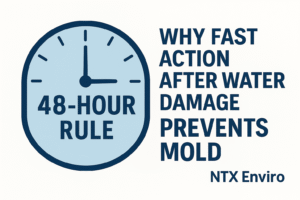Many homeowners know mold can damage their property—but few realize the serious health risks mold can cause. If you or your family have been dealing with unexplained coughing, allergies, or fatigue at home, mold may be the hidden culprit.
Mold exposure affects everyone differently. For some, it causes mild irritation; for others, it can trigger severe health problems. In this post, NTX Enviro explains the most common symptoms of mold exposure, why they happen, and when to seek a professional inspection.
Why Mold Can Make You Sick
Mold reproduces by releasing tiny spores into the air. When inhaled, these spores, and the fragments they break into, can irritate the respiratory system and trigger allergic reactions.
- Airborne Spores: Even if mold is hidden behind walls or under flooring, spores travel through your home’s air.
- Mycotoxins: Some molds produce toxic substances that may cause additional health issues.
- Moisture Link: Mold grows where humidity or water damage exists, meaning homes with leaks or poor ventilation are at higher risk.
Common Mold-Related Health Symptoms
While not every person reacts to mold the same way, there are several symptoms frequently reported with mold exposure.
- Respiratory Problems
- Persistent coughing or wheezing
- Shortness of breath
- Chest tightness or discomfort
- Asthma flare-ups
People with asthma or other respiratory conditions often experience worsening symptoms when mold is present.
- Allergy-Like Reactions
- Sneezing and runny nose
- Itchy or watery eyes
- Nasal congestion
- Sore throat
These reactions often mimic seasonal allergies, but if they persist indoors year-round, mold may be the cause.
- Headaches and Fatigue
- Frequent headaches or migraines
- Trouble concentrating
- Chronic tiredness
This is especially common in homes with hidden mold, where exposure is ongoing but not obvious.
- Skin Irritation
- Rashes or redness
- Itching or hives
- Dry, flaky skin
Direct contact with moldy materials (like furniture or clothing) can trigger skin irritation.
- More Severe Symptoms (in vulnerable individuals)
- Increased risk of infections (especially in those with weakened immune systems)
- Chronic sinus infections
- Severe asthma attacks
Children, the elderly, and people with compromised immune systems are at the greatest risk.
How to Tell If Mold Is Causing Your Symptoms
Since mold symptoms often overlap with allergies, colds, or other conditions, it can be hard to know the source. Here are some ways to narrow it down:
- Do your symptoms improve when you leave home? If you feel better at work, on vacation, or outdoors, your home may be the source.
- Has your home had water damage? Past leaks, floods, or high humidity create perfect mold conditions.
- Do multiple family members have similar issues? If everyone in the household has allergy-like symptoms, it may be mold exposure.
The Link Between Mold and Indoor Air Quality
Mold growth directly impacts indoor air quality (IAQ). Spores, fragments, and even mold odors reduce the overall health of your living environment.
- Poor IAQ contributes to long-term respiratory issues.
- Mold often coexists with dust mites, bacteria, and other allergens.
- A professional air quality test can confirm whether mold is contributing to your symptoms.
(NTX Enviro Mold Inspection Services)
What to Do If You Suspect Mold Is Making You Sick
- Document Symptoms and Conditions
Keep track of when symptoms occur, where they’re worst in your home, and whether they improve when you leave the property.
- Inspect Your Home for Red Flags
Look for:
- Musty odors
- Water stains
- Peeling paint or bubbling drywall
- Visible mold spots
- Schedule a Professional Mold Assessment
In Texas, licensed mold consultants (like NTX Enviro) are trained to:
- Conduct moisture mapping and thermal imaging
- Perform air and surface sampling with accredited lab testing
- Provide a detailed report with findings and recommendations
- Guide you through compliance with the Texas Mold Law (Occupations Code, Chapter 1958)
- Seek Medical Advice
If symptoms are severe or persistent, consult a healthcare provider. Let them know about possible mold exposure so they can tailor treatment.
DIY vs. Professional Solutions
- DIY Cleanup: Small areas (<25 sq. ft.) on non-porous surfaces may be cleaned with detergent and dried thoroughly.
- Professional Remediation: For widespread growth, hidden mold, or recurring symptoms, professional remediation guided by a licensed assessment is essential.
DIY Mold Cleanup vs. Preofessional Assessment: What’s the Difference?
Conclusion
Mold exposure can cause everything from mild allergies to serious respiratory problems. If you or your family are experiencing persistent symptoms at home, especially after water damage or in humid conditions, mold may be the cause.
The best way to confirm it? A professional mold inspection that combines visual assessment, moisture detection, and laboratory testing. By identifying the source early, you can protect both your health and your home.
Don’t ignore the warning signs. If you suspect mold is making you sick, take action today.
👉 Schedule a Professional Mold Inspection with NTX Enviro
Our licensed consultants provide unbiased testing, clear reporting, and peace of mind—so you and your family can breathe easier.

